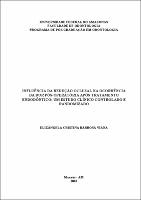| ???jsp.display-item.social.title??? |


|
Please use this identifier to cite or link to this item:
https://tede.ufam.edu.br/handle/tede/6229| ???metadata.dc.type???: | Dissertação |
| Title: | Influência da redução oclusal na ocorrência da dor pós-operatória após tratamento endodôntico: Um estudo clínico controlado e randomizado |
| ???metadata.dc.creator???: | Viana, Elizângela Cristina Barbosa  |
| ???metadata.dc.contributor.advisor1???: | Sponchiado Junior, Emílio Carlos |
| ???metadata.dc.contributor.referee1???: | Marques, André Augusto Franco |
| ???metadata.dc.contributor.referee2???: | Pimentel, Gustavo Henrique Diniz |
| ???metadata.dc.description.resumo???: | O objetivo deste estudo foi avaliar a influência da redução oclusal na ocorrência da dor pósoperatória após tratamento endodôntico realizado com sistema reciprocante, a partir de um estudo clínico, prospectivo, randomizado, duplo cego realizado na Clínica Odontológica da UFAM. Foram selecionados 78 pacientes, idade média de 28 anos, divididos aleatoriamente em 2 grupos, com indicação de tratamento endodôntico em dentes molares diagnosticados com Pulpite Irreversível. No grupo experimental (RO), foi realizado o tratamento endodôntico com o sistema WaveOne® Gold e realizado a redução oclusal. No grupo controle (SRO), foi realizado o tratamento endodôntico com o sistema Wave One® Gold sem redução oclusal. Todo o tratamento foi realizado pelo mesmo operador. Foi registrada a ocorrência e intensidade da dor em duas escalas de aferição de dor: a de descrição verbal (VRS) e a numérica discreta (NRS). Os dados foram analisados pelo programa STATA® pelos testes de Mann-Whitney, Qui-quadrado e exato de Fisher (p<0,05). A avaliação da dor foi realizada nos intervalos de 6, 24 e 72 horas após o tratamento endodôntico. No grupo experimental, com redução oclusal, 71,1% (n=27) relataram dor pós-operatória e no grupo controle 67,5% (n=27). Tanto o quantitativo de indivíduos que relataram dor quanto a magnitude da mesma diminuíram ao longo do período analisado. Na avaliação com 6h, 21 indivíduos relataram dor no grupo experimental e 24 no grupo controle (p=0,672). Com 24 horas esse quantitativo foi 18 e 19 (p=0,991) e com 72 horas 8 e 4 (p=0,219), respectivamente. Não foram encontradas diferenças significativas na intensidade de dor pós-operatória entre os grupos em 6 horas (VRS, p=0,719; NRS, p=0,547), 24 horas (VRS, p= 0,906; NRS, p= 0,987) e 72 horas (VRS, p= 0,178; NRS, p=0,176) tanto para a escala VRS quanto para a NRS. Foi concluído que a redução oclusal não influenciou na dor pós-operatória nos dentes com pulpite irreversível. |
| Abstract: | The aim of this study was to evaluate the influence of occlusal reduction on the occurrence of postoperative pain after endodontic treatment performed with WaveOne® Gold reciprocanting system, based on a prospective randmozed, double-blind clinical trial conducted at the UFAM Dentistry College. This study included 78 patients, mean age 28 years, randomly divided into 2 groups, with indication of endodontic treatment in molar teeth diagnosed with Pulpite Irreversible. In the experimental group (RO), the endodontic treatment with the Wave One® Gold system was performed and the occlusal reduction was performed. In the control group (SRO), the endodontic treatment was performed with the WaveOne® Gold system. All treatment was performed by the same operator. The pain evaluation was performed at 6, 24 and 72 hours intervals after the endodontic treatment was performed. The occurrence and intensity of pain were recorded on two pain scales: verbal description (VRS) and discrete numeral (NRS). The data were analyzed by the STATA® program by the Mann- Whitney, χ2 and Fisher test (p<0,05). In the experimental group, with occlusal reduction, 71.1% (n = 27) reported postoperative pain and in the control group 67.5% (n = 27). Both the number of individuals who reported pain and the magnitude of pain decreased over the analyzed period. In the 6h evaluation, 21 subjects reported pain in the experimental group and 24 in the control group (p=0,672). At 24 hours this quantitative was 18 and 19 (p=0,991) and at 72 hours 8 and 4 (p=0,219), respectively. No significant differences in postoperative pain intensity were found between the groups at 6 hours (VRS, p=0,719; NRS, p=0,547), 24 hours (VRS, p= 0,906; NRS, p= 0,987) and 72 hours (VRS, p= 0,178; NRS, p=0,176) for both the VRS and NRS scales. It was concluded that, within the limitation of the present study, occlusal reduction did not influence pain postoperative period in the teeth with irreversible pulpitis. |
| Keywords: | Redução oclusal Dor pós-operatória Tratamento endodôntico Terapia do canal radicular Occlusal reduction Postoperative pain Endodontic treatment Root canal therapy |
| ???metadata.dc.subject.cnpq???: | CIÊNCIAS DA SAÚDE: ODONTOLOGIA |
| Language: | por |
| ???metadata.dc.publisher.country???: | Brasil |
| Publisher: | Universidade Federal do Amazonas |
| ???metadata.dc.publisher.initials???: | UFAM |
| ???metadata.dc.publisher.department???: | Faculdade de Odontologia |
| ???metadata.dc.publisher.program???: | Programa de Pós-graduação em Odontologia |
| Citation: | VIANA, Elizângela Cristina Barbosa. Influência da redução oclusal na ocorrência da dor pós-operatória após tratamento endodôntico: Um estudo clínico controlado e randomizado. 2018. 57 f. Dissertação (Mestrado em Odontologia) - Universidade Federal do Amazonas, Manaus, 2018. |
| ???metadata.dc.rights???: | Acesso Aberto |
| ???metadata.dc.rights.uri???: | http://creativecommons.org/licenses/by-nc-nd/4.0/ |
| URI: | http://tede.ufam.edu.br/handle/tede/6229 |
| Issue Date: | 2-Feb-2018 |
| Appears in Collections: | Mestrado em Odontologia |
Files in This Item:
| File | Description | Size | Format | |
|---|---|---|---|---|
| Dissertação_Elizângela C. B. Viana.pdf | 1.36 MB | Adobe PDF |  Download/Open Preview |
This item is licensed under a Creative Commons License





